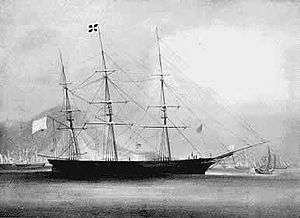William Henry Aspinwall
| William Henry Aspinwall | |
|---|---|
| Born |
December 16, 1807 Manhattan |
| Died |
January 18, 1875 (aged 67) Manhattan |
| Cause of death | Myocardial infarction |
| Resting place | Green-Wood Cemetery |
| Nationality | American |
| Occupation | Shipping magnate |
| Organization | Howland & Aspinwall, the Pacific Mail Steamship Company |
| Net worth | USD $4 million at the time of his death (approximately 1/913th of US GNP)[1] |
| Spouse(s) | Anna Lloyd |
William Henry Aspinwall (December 16, 1807 – January 18, 1875)[2][3] was an American businessman.

In 1832, he became president of the Howland & Aspinwall merchant firm, which had been founded by his cousin and expanded trade to South America, China, Europe, the Mediterranean, and the East and West Indies. Howland & Aspinwall owned some of the most famous clipper ships ever built. In 1845, while the firm owned the Ann McKim which was regarded as the fastest ship afloat, it built the Rainbow, which was even faster. The Rainbow was the high-tech racehorse of its day, and is considered to be the first of the extreme clippers. Instead of the bluff bow that was customary on ships up until that time, the Rainbow had a sharp bow, prompting on-lookers to joke that maybe she would sail better backwards. The next year, Howland & Aspinwall had the Sea Witch built, which set a speed record from China to New York which still stands.[4]

Clipper ships sacrificed cargo capacity for speed, but in some markets, the fast service allowed their owners to charge premium rates (Tea from China tasted better if it was fresh, so the cargo on the first ship of the season to arrive in New York was worth more). Also faster speed meant that the vessel could complete more voyages in a given time period, which also helped make up for the diminished cargo capacity.

In 1848 Aspinwall founded the Pacific Mail Steamship Company, to provide service to California. This turned out to be a rather good year in which to start a steamship line to California, since the Gold Rush started the next year. The company's first vessel to make the trip was packed with passengers. Pacific Mail became American President Lines,[5] which is now part of Neptune Orient Lines.[6] He then promoted the Panama Railroad across the Isthmus of Panama.
He retired in 1856 but remained active as a philanthropist. He was a founder of the American Society for the Prevention of Cruelty to Animals (1866) and of the Metropolitan Museum of Art (1869).[7]
William Henry Aspinwall is interred at Green-Wood Cemetery in Brooklyn, New York.
References
- ↑ Klepper, Michael; Gunther, Michael (1996), The Wealthy 100: From Benjamin Franklin to Bill Gates—A Ranking of the Richest Americans, Past and Present, Secaucus, New Jersey: Carol Publishing Group, p. xiii, ISBN 978-0-8065-1800-8, OCLC 33818143
- ↑ "Obituary: William H. Aspinwall" (PDF). New York Times. January 19, 1875. Retrieved December 16, 2008.
- ↑ Levy, D.A. (February 14, 2004). "William Henry Aspinwall". The Maritime Heritage Project. Retrieved December 16, 2008.
- ↑ Somerville, Col. Duncan S., The Aspinwall Empire, p. 22, Mystic Seaport Museum, Inc., Mystic, CT, 1983.
- ↑ Niven, John, The American President Lines and its Forebears 1948-1984, p. 15, University of Delaware Press, Newark, NJ, 1987.
- ↑ Elias, Rahita, Beyond Boundaries: The First 35 Years of the NOL Story, p. 8, Neptune Orient Lines Ltd., 2004.
- ↑ "William Henry Aspinwall (1807-1875)". Trainweb. Retrieved December 16, 2008.
External links
- William Henry Aspinwall at Find a Grave
- American President Lines official website
- Mystic Seaport official website
- Green-Wood Cemetery Burial Search